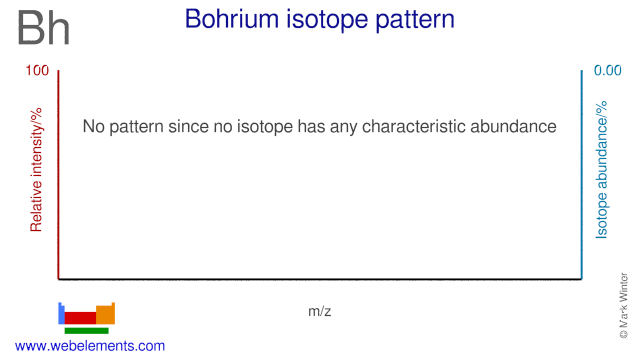Bohrium - 107Bh: the essentials
- Name: bohrium
- Symbol: Bh
- Atomic number: 107
- Relative atomic mass (Ar): [ 270 ] (longest lived isotope)
- Standard state: presumably a solid at 298 K
- Appearance: unknown, but probably metallic and silvery white or grey in appearance
- Classification: Metallic
- Group in periodic table: 7
- Group name: (none)
- Period in periodic table: 7
- Block in periodic table: d
- Shell structure: 2.8.18.32.32.13.2
- CAS Registry: 54037-14-8
Bohrium atoms have 107 electrons and the shell structure is 2.8.18.32.32.13.2. The ground state electronic configuration of neutral bohrium is [Rn].5f14.6d5.7s2 (a guess based upon that of rhenium) and the term symbol of bohrium is 6S5/2 (a guess based upon guessed electronic structure).
Bohrium: description
Bohrium is a synthetic element that is not present in the environment at all. The German discoverers at GSI proposed the name Nielsbohrium (symbol Ns) after Niels Bohr. IUPAC are happy to name an element after Bohr but suggest bohrium (Bh) on the grounds that the first name of a person does not appear in the names of any other element named after a person. This seems to have been accepted by all concerned.
The interested reader should consult the on-line version of Creating Super Heavy Elements for a fascinating insight into research on "super-heavy" atoms.
Bohrium: physical properties
Density of solid: 27200 (predicted) kg m-3
Molar volume: 10 (rough estimate based upon density estimate) cm3
Thermal conductivity: (no data) W m‑1 K‑1
Bohrium: heat properties
Melting point: (no data) K
Boiling point: (no data) K
Enthalpy of fusion: 20.5 kJ mol-1
Bohrium: atom sizes
Atomic radius (empirical): (no data) pm
Molecular single bond covalent radius: 141 (coordination number 5) ppm
van der Waals radius: (no data) ppm
Bohrium: electronegativities
Pauling electronegativity: (no data) (Pauling units)
Allred Rochow electronegativity: (no data) (Pauling units)
Mulliken-Jaffe electronegativity: (no data)
Bohrium: orbital properties
First ionisation energy: 743 (inferred) kJ mol‑1
Second ionisation energy: 1690 kJ mol‑1
Third ionisation energy: 2580 kJ mol‑1
Bohrium: abundances
Universe: (no data) ppb by weight
Crustal rocks: (no data) ppb by weight
Human: (no data) ppb by weight
Bohrium: crystal structure

Bohrium: biological data
Human abundance by weight: (no data) ppb by weight
Bohrium has no biological role.
Bohrium: uses
Bohrium: reactions
Reactions of bohrium as the element with air, water, halogens, acids, and bases where known.
Bohrium: binary compounds
Binary compounds with halogens (known as halides), oxygen (known as oxides), hydrogen (known as hydrides), and other compounds of bohrium where known.
Bohrium: compound properties
Bond strengths; lattice energies of bohrium halides, hydrides, oxides (where known); and reduction potentials where known.
Bohrium: history
Bohrium was discovered by Peter Armbruster, Gottfried Münzenber and their co-workers. in 1981 at Gesellschaft für Schwerionenforschung (GSI) in Darmstadt, Germany.. Origin of name: the origin of the name is Niels "Bohr", the Danish physicist..Bohrium: isotopes

Bohrium: isolation
Isolation: only a few atoms of element 107, bohrium, have ever been made. The first atoms were made through a nuclear reaction involving fusion of an isotope of lead, 209Pb, with one of chromium, 54Cr.
209Pb + 54Cr → 262Bh + 1n
Isolation of an observable quantity of bohrium has never been achieved, and may well never be. This is because bohrium decays very rapidly through the emission of α-particles.
More recently, other isotopes have been made at the Paul Scherrer Institute (PSI) in Switzerland.
249Bk + 22Ne → 266Bh + 51n
249Bk + 22Ne → 267Bh + 41n
In this work, it appears the scientists concerned feel bohrium forms the oxychloride BhClO3.
